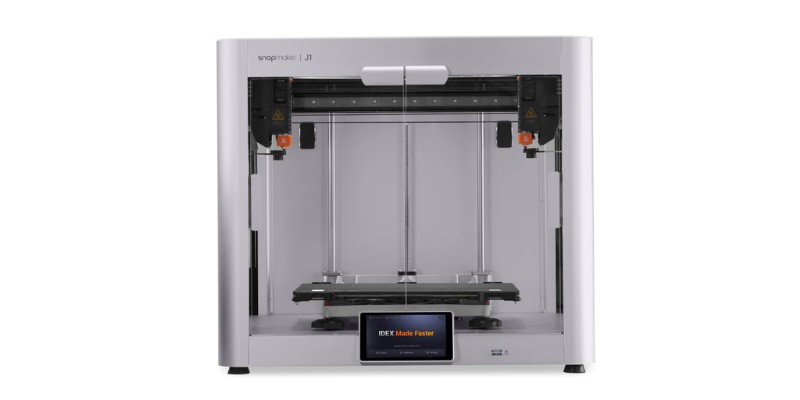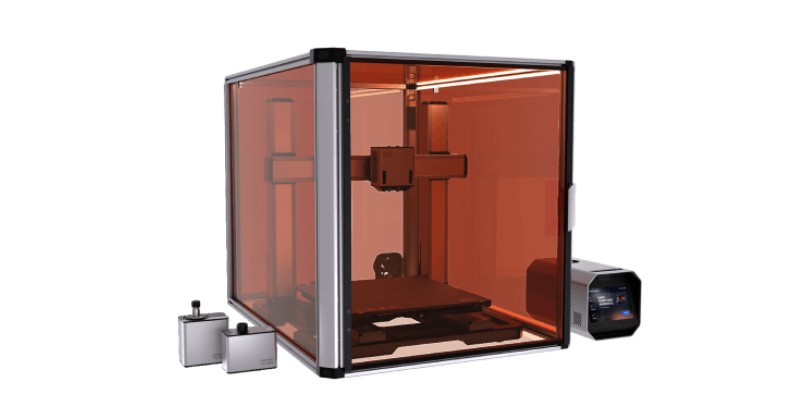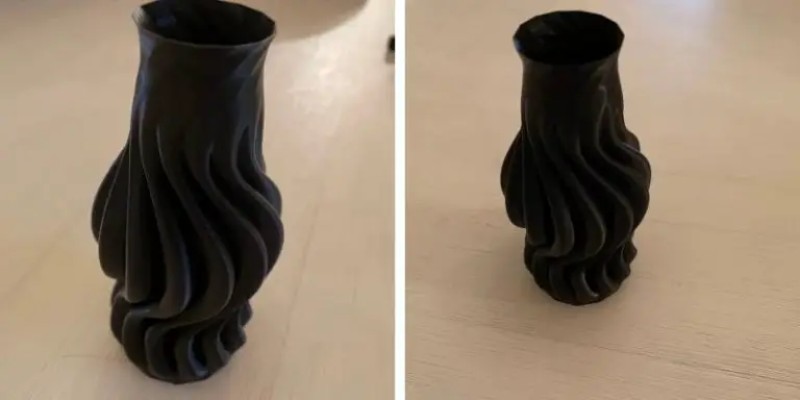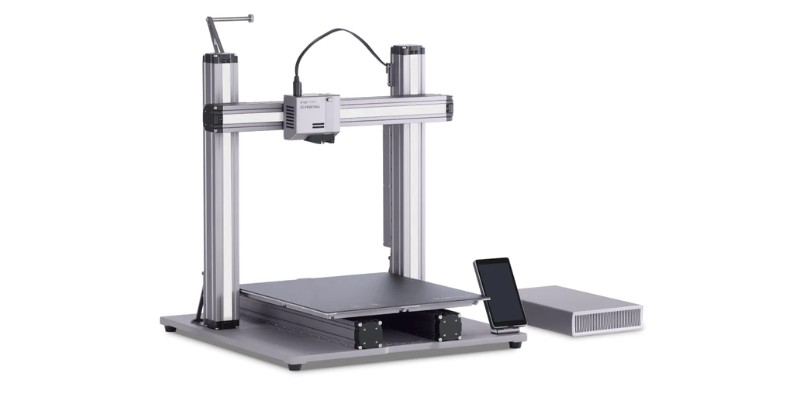
Snapmaker devices can be difficult to compare because of their multi-function designs, especially true for the J1, Artisan, and 2.0 AT and F models.
They range from standard 3D printing, to an all-in-one package with high-quality laser cutting, engraving, CNC, and dual extrusion printing. As such, they vary wildly in price and specs.
Snapmaker has created an impressive lineup of devices that work for a variety of different hobbyists and projects. In this article, we’ll cover the main selling points of each printer and which situations would make them a worthy purchase.
Let’s get started.
| Snapmaker J1 | Snapmaker Artisan | Snapmaker 2.0 A250T | Snapmaker 2.0 A350T | Snapmaker 2.0 F250 | Snapmaker 2.0 F350 | |
|---|---|---|---|---|---|---|
| Build Volume (3D Printing) | 300 x 200 x 200 mm | 350 x 400 x 400 mm | 230 x 250 x 235 mm | 320 x 350 x 330 mm | 230 x 250 x 235 mm | 320 x 350 x 330 mm |
| Machine Footprint | 539 mm x 401 mm x 464 mm | 665 mm x 943 mm x 705 mm | 405 x 424 x 490 mm | 495 x 506 x 580 mm | 405 x 424 x 490 mm | 495 x 506 x 580 mm |
| Build Plate | Double-sided PEI Glass Plate | Double-sided PEI-coated Glass | Double-sided PEI Flex Plate | Double-sided PEI Flex Plate | Double-sided PEI Flex Plate | Double-sided PEI Flex Plate |
| Extruder Type | Direct Drive | Direct Drive | Direct Drive | Direct Drive | Direct Drive | Direct Drive |
| Filament Compatibility | PLA, ABS, HIPS, PC, TPU, TPE, PETG, ASA, PP, PVA, PA, PA-GF, PA-CF | PLA, ABS, ASA, PETG, TPU, Breakaway PLA, PVA, HIPS, Nylon, Carbon Fiber Reinforced Nylon, Glass Fiber Reinforced Nylon | PLA, ABS, PETG, TPU, wood filled PLA, and more being tested | PLA, ABS, PETG, TPU, wood filled PLA, and more being tested | PLA, ABS, PETG, TPU, wood filled PLA, more being tested | PLA, ABS, PETG, TPU, wood filled PLA, more being tested |
| Max Extruder Temp | 300°C | 300°C | 275°C | 275°C | 300°C | 300°C |
| Max Bed Temp | 100°C | 110°C | 100°C | 80°C | 100°C | 80°C |
| IDEX? | Yes | No (dual extrusion) | No | No | No (dual extrusion) | No (dual extrusion) |
| Laser Cutting? | No | Yes | Yes | Yes | No (can be added) | No (can be added) |
| Supported Materials for Laser Cutting | N/A | Basswood, Paulownia, Pinewood, Plywood, Beech, Walnut, Bamboo, MDF, Leather, Fabric, Canvas, Corrugated Paper, Cardboard, Plastic, Dark Acrylic (Blue excluded) | Wood, leather, plastic, fabric, paper, non-transparent acrylic, and more being tested | Wood, leather, plastic, fabric, paper, non-transparent acrylic, and more being tested | N/A | N/A |
| Laser Wattage | N/A | 10W | 1.6W | 1.6W | N/A | N/A |
| CNC Carving? | No | Yes | Yes | Yes | No | No |
| CNC Wattage | N/A | 200W | 50W | 50W | N/A | N/A |
| Supported Materials for CNC | N/A | Hardwood (Beech, Walnut), Softwood, HDF, MDF, Plywood, Jade, Carbon Fiber, Acrylic, Epoxy Tooling Board, PCB | Wood, acrylic, PCB, carbon fiber sheet, jade, and more being tested | Wood, acrylic, PCB, carbon fiber sheet, jade, and more being tested | N/A | N/A |
| Enclosed? | Yes | Yes | No | No | No | No |
| Auto Bed-leveling? | Yes | No | Yes | Yes | Yes | Yes |
| Resume Print and Filament Sensor? | Yes | No | Yes | Yes | Yes | Yes |
| Touchscreen? | Yes | Yes | Yes | Yes | Yes | Yes |
| Connectivity | Wi-Fi, USB cable, USB flash drive | Wi-Fi, USB cable, USB flash drive | Wi-Fi, USB cable, USB flash drive | Wi-Fi, USB cable, USB flash drive | Wi-Fi, USB cable, USB flash drive | Wi-Fi, USB cable, USB flash drive |
| Price | $1,200 | $2,900 | $1,000 | $1,200 | $770 | $850 |
Snapmaker J1 vs Artisan vs 2.0 AT and F: A Quick Summary
Snapmaker J1
- Price: Check latest price at Snapmaker here
- Build volume: 300 x 200 x 200 mm
- Filament compatibility: PLA, ABS, HIPS, PC, TPU, TPE, PETG, ASA, PP, PVA, PA, PA-GF, PA-CF
- Layer height: 50 – 300 microns
- Printing accuracy: ± 0.1 mm
- Max extruder temp: 300°C
- Max bed temp: 100°C
- Connectivity: Wi-Fi, USB cable, USB flash drive

The Snapmaker J1 fits into an interesting niche compared to Snapmaker’s other 3D printers. It doesn’t have any of the multi-function capabilities of the Artisan or 2.0 models, but it does have IDEX (independent dual extruders).
These extruders open up a world of opportunities for 3D printing. You can use a wide range of filaments with it, like PLA, ABS, HIPS, and PC, as well as flexible filaments like TPU and TPE.
The J1 has a maximum extruder temperature of 300°C and a maximum bed temperature of 100°C. It includes an enclosure by default and uses a PEI glass plate. Combined with its build volume of 300 x 200 x 200 mm, it’s well-outfitted to handle a variety of projects.
It also has the quality of life features to make it welcoming to new and old hobbyists alike. The Snapmaker J1 has a filament runout sensor, a 5” touchscreen, and a simple auto bed-leveling system.
Ultimately, the J1 is an amazing option for anyone looking for an IDEX printer. It provides enough support and quality that even beginners could pick it up, which is great to see in a dual-extruder printer. The main downside, if you can call it that, is that the J1 isn’t built to be anything but a 3D printer – which might make you consider an Artisan or 2.0 instead.
Snapmaker Artisan
- Price: Check latest price at Snapmaker here
- Build volume: 350 x 400 x 400 mm
- Filament compatibility: PLA, ABS, ASA, PETG, TPU, Breakaway PLA, PVA, HIPS, Nylon, Carbon Fiber Reinforced Nylon, Glass Fiber Reinforced Nylon
- Laser cutting materials: Basswood, Paulownia, Pinewood, Plywood, Beech, Walnut, Bamboo, MDF, Leather, Fabric, Canvas, Corrugated Paper, Cardboard, Plastic, Dark Acrylic (Blue excluded)
- CNC materials: Hardwood (Beech, Walnut), Softwood, HDF, MDF, Plywood, Jade, Carbon Fiber, Acrylic, Epoxy Tooling Board, PCB
- Layer height: 50 – 300 microns
- Printing accuracy: ± 0.1 mm
- Max extruder temp: 300°C
- Max bed temp: 110°C
- Laser module: 10W
- CNC cutting module: 200W
- Connectivity: Wi-Fi, USB cable, USB flash drive

The Snapmaker Artisan is a high profile (winning the CES innovation award), high cost, and highly upgraded version of the 2.0 models. It uses a quick-swap design that’s reminiscent of the modular 2.0 F.
Included in the couple thousand dollar package is the ability to swap between 3D printing with a dual extruder, laser engraving and cutting, and CNC engraving and cutting. Despite being a 3-in-1 device, it doesn’t sacrifice the individual quality of any function.
The laser cutter module can work with a variety of woods, leather, plastic, and acrylics, while the CNC module can work with woods, plastics, carbon fiber, acrylics, and even stones like Jade. Both modules are high power: 10W and 200W respectively.
On the 3D printing side of things, you still have many options. The Artisan’s max extruder temperature of 300°C and max bed temperature of 110°C, paired with a dual-sided PEI and glass build plate and an enclosure, let you use filaments like PETG, ABS, TPU, Nylon, Carbon Fiber Reinforced Nylon, and more.
The Snapmaker Artisan doesn’t let up with smaller features, either. It boasts an updated UI and a 7” touch screen, which makes it easy to use.
Overall, the Artisan is an incredible tool that can only be replaced by purchasing high-quality versions of each machine separately. As it stands, its main pitfall is that it does lack some smaller features – possibly because it’s a 3-in-1 machine. It doesn’t have auto bed-leveling or a filament sensor, and the dual extruder is not IDEX.
Snapmaker 2.0 (AT Models)
- Price: Check latest price at Snapmaker here
- Build volume (A250T): 230 x 250 x 235 mm
- Build volume (A350T): 320 x 350 x 330 mm
- Filament compatibility (A250T and A350T): PLA, ABS, PETG, TPU, wood filled PLA, and similar
- Laser cutting materials: Wood, leather, plastic, fabric, paper, non-transparent acrylic
- CNC materials: Wood, acrylic, PCB, carbon fiber sheet, jade
- Layer height: 50 – 300 microns
- Printing accuracy: ± 0.1 mm
- Max extruder temp (A250T and A350T): 275°C
- Max bed temp (A250T): 100°C
- Max bed temp (A350T): 80°C
- Laser module: 1.6W
- CNC cutting module: 50W
- Connectivity: Wi-Fi, USB cable, USB flash drive

The A250T and the A350T are both complete packages including a 3D printer, a laser cutting module, and a CNC module. While neither of them are as expensive as the premium Snapmaker Artisan, they are reasonably well-equipped.
As the cheaper model, the A250T has a lower build volume of 230 x 250 x 235 mm compared to the A350T’s 320 x 350 x 330 mm. The work areas for the laser and CNC modules are the same, at 230 x 250 mm and 320 x 350 mm, respectively.
The differences are minimal aside from work area size. There’s a decent range of filaments, including PLA, ABS, PETG, TPU, and wood-filled PLA for both the A250T and A350T.
The maximum extruder temperature on both models is 275°C, which helps the ATs print with those trickier filaments like wood-filled and TPU. However, the laser cutting and CNC modules aren’t quite as impressive. The default laser is 1.6W, and you have to pay an extra few hundred dollars to get the 10W high-power laser module that comes with the Artisan by default. The 50W CNC head is also significantly weaker than the 200W Artisan CNC.

However, I still managed to cut wood with the 1.6W laser (I also have the 10W module for my Snapmaker 2.0, though), and fashioned an accurate chess piece using the 4-axis rotary module on some epoxy resin.
They come with a laser camera for seamless calibration, helpful carving bits for CNC work, and are perfectly designed for fast swapping between modules.
Although the AT models aren’t enclosed, they’re well-stocked with filament sensors, auto bed-leveling, and touchscreens. You can also read my full review of the Snapmaker 2.0 A350T.
Snapmaker 2.0 (F Models)
- Price: Check latest price at Snapmaker here
- Build volume (F250): 230 x 250 x 235 mm
- Build volume (F350): 320 x 350 x 330 mm
- Filament compatibility (F250 and F350): PLA, ABS, PETG, TPU, wood filled PLA, and similar
- Layer height: 50 – 300 microns
- Printing accuracy: ± 0.1 mm
- Max extruder temp (F250 and F350): 300°C
- Max bed temp (F250): 100°C
- Max bed temp (F350): 80°C
- Connectivity: Wi-Fi, USB cable, USB flash drive

Compared to the Snapmaker 2.0 AT and A models, the Snapmaker 2.0 F models are more about versatility and flexibility. They don’t come with any modules by default, but you have the option of purchasing them. As you might expect, they’re cheaper printers that work better for entry-level hobbyists.
Like the AT models, the F250 has a build volume of 230 x 250 x 235 mm compared to the F350’s 320 x 350 x 330 mm.
The filament compatibility is also the same on the F models compared to the AT models, with PLA, ABS, PETG, TPU, wood-filled PLA, and similar filaments. That’s because the build plate (double-sided PEI and glass) is the same, and the maximum extruder temperature (300°C) is actually higher than on the AT models.
As a 3D printer first and foremost, the F250 and F350 have filament runout sensors and auto bed-leveling – which are not with the Artisan.
Between the F250 and F350, Snapmaker claims to have upgraded the F350 to have much faster print times without sacrificing quality. Both F models have touchscreens and an upgraded cooling system.
The quality of the laser cutting/engraving and CNC modules should be about the same as on the AT models. Even the system of swapping them is more or less the same– the only difference is needing to purchase the modules separately.
However, the F models have a trump card over the 2.0 ATs: they have a dual extruder. They aren’t IDEX, but dual extrusion gives you more flexibility with your projects. Increased flexibility and versatility are what the Snapmaker 2.0 F printers are all about.
Comparison Showdown
Functions
| 3D Printer | Functions |
|---|---|
| Snapmaker J1 | Dual extrusion 3D printing (IDEX) |
| Snapmaker Artisan | Dual extrusion 3D printing, Laser cutting, Laser engraving, and CNC cutting |
| Snapmaker 2.0 (AT Models) | 3D printing, Laser engraving, and CNC cutting |
| Snapmaker 2.0 (F Models) | Dual extrusion 3D printing (modular capability) |
Each Snapmaker device fits in its own unique niche.
Although they’re all makerspace-worthy, the Snapmaker Artisan has the most functionality overall. It can do laser engraving and cutting thanks to the higher power laser, CNC cutting, and dual extrusion 3D printing.
The Artisan is compatible with more modules than the AT or F models. You can see a complete list of compatible modules on the product page.
The only thing the Artisan doesn’t have are independent dual extruders, which are better compared to dual extruders built into the same print head. IDEX 3D printers can set different temperatures for each print head, and so print multiple filaments, and multiple objects simultaneously.
By a technicality, the AT models have more functionality than the F models – but only until you purchase modules to add. If you buy a laser engraving and a CNC cutting module, then you’ll have everything the AT models have – but with dual extrusion.
The J1 is dead last when it comes to functionality. It’s not made to be multi-purpose like the other Snapmaker devices, which isn’t necessarily a bad thing. The Snapmaker J1 does its job of being a high-quality IDEX printer quite well.
When making your decision, remember the differences between 3D printing capabilities between the printers are relatively minimal. They can all print quality designs using a wide range of filaments.
Build Volumes and Work Areas
| 3D Printer | Build Volume and Work Areas |
|---|---|
| Snapmaker J1 | 300 x 200 x 200 mm |
| Snapmaker Artisan | 350 x 400 x 400 mm |
| Snapmaker 2.0 A250T | 230 x 250 x 235 mm |
| Snapmaker 2.0 A350T | 320 x 350 x 330 mm |
| Snapmaker 2.0 F250 | 230 x 250 x 235 mm |
| Snapmaker 2.0 F350 | 320 x 350 x 330 mm |
The Snapmaker Artisan is meaningfully larger than all of the others at an impressive 350 x 400 x 400 mm. The Snapmaker 2.0 A350T and F350 are in second place, at 320 x 350 x 330 mm.
The Artisan, as a more ‘premium’ device, will give you the most leeway to create fun pieces. But we feel the work area alone likely isn’t worth the increased price. You should stick with the 2.0 A350T or F350 if you want a larger build volume and don’t need the extra features.
Although the Snapmaker J1 is a perfectly reasonable middle ground for a 3D printer at 300 x 200 x 200 mm, the smaller sizes of the Snapmaker 2.0 models might give you some trouble. Make sure you carefully consider not only what you want to 3D print, but which projects you would use CNC or laser modules on.
Temp Resistance and Wattage
| Max Extruder Temp | Max Bed Temp | CNC Wattage | Laser Wattage | |
|---|---|---|---|---|
| Snapmaker J1 | 300°C | 100°C | N/A | N/A |
| Snapmaker Artisan | 300°C | 110°C | 10W | 200W |
| Snapmaker 2.0 A250T | 275°C | 100°C | 1.6W | 50W |
| Snapmaker 2.0 A350T | 275°C | 80°C | 1.6W | 50W |
| Snapmaker 2.0 F250 | 300°C | 100°C | N/A | N/A |
| Snapmaker 2.0 F350 | 300°C | 80°C | N/A | N/A |
Once again, the Snapmaker Artisan proves its higher quality through high-power CNC and laser modules, and a high-temperature extruder.
Most Snapmaker printers have similar max temperatures. However, you can swap in higher-quality pieces if need be.
Since the Artisan and 2.0 models are modular, you could get some of the Artisan’s specs on the 2.0 models. Compatibility can be found in the FAQ section of the Artisan’s product page.
The 10W high power laser module works for the A250T, A350T, F250, and F350 (I have the 10W module on my Snapmaker 2.0).
However, the 200W CNC module that Artisan uses doesn’t work with any of the other 2.0 models. If you want CNC power, the Artisan is the way to go.
At base, the modules that come with the AT models aren’t all that special. The laser module uses 1.6W and the CNC module uses 50W, far from the Artisan’s quality.
It could be worthwhile to purchase a 2.0 F model and a 10W laser module if you’re the most interested in having the laser engraving/cutting capability. Keep in mind, though, that it won’t offer cost savings since the 10W laser module is $490 and even the F250 is $770 at base.
The benefit of opting for this path is that you’d get a higher-wattage laser for around the same price as the A350T. We also have a standalone review of the Snapmaker 10W laser module.
Filaments and Materials
| Filaments | CNC Materials | Laser Materials | |
|---|---|---|---|
| Snapmaker J1 | PLA, ABS, HIPS, PC, TPU, TPE, PETG, ASA, PP, PVA, PA, PA-GF, PA-CF | N/A | N/A |
| Snapmaker Artisan | PLA, ABS, ASA, PETG, TPU, Breakaway PLA, PVA, HIPS, Nylon, Carbon Fiber Reinforced Nylon, Glass Fiber Reinforced Nylon | Hardwood (Beech, Walnut), Softwood, HDF, MDF, Plywood, Jade, Carbon Fiber, Acrylic, Epoxy Tooling Board, PCB | Basswood, Paulownia, Pinewood, Plywood, Beech, Walnut, Bamboo, MDF, Leather, Fabric, Canvas, Corrugated Paper, Cardboard, Plastic, Dark Acrylic (Blue excluded) |
| Snapmaker 2.0 A250T | PLA, ABS, PETG, TPU, wood filled PLA, and more being tested | Wood, acrylic, PCB, carbon fiber sheet, jade, and more being tested | Wood, leather, plastic, fabric, paper, non-transparent acrylic, and more being tested |
| Snapmaker 2.0 A350T | PLA, ABS, PETG, TPU, wood filled PLA, and more being tested | Wood, acrylic, PCB, carbon fiber sheet, jade, and more being tested | Wood, leather, plastic, fabric, paper, non-transparent acrylic, and more being tested |
| Snapmaker 2.0 F250 | PLA, ABS, PETG, TPU, wood filled PLA, and more being tested | N/A | N/A |
| Snapmaker 2.0 F350 | PLA, ABS, PETG, TPU, wood filled PLA, and more being tested | N/A | N/A |
Snapmaker tests materials and filaments for each printer in-house, which makes it easy to know which materials are good to go. Unfortunately, the materials that they’ve tested don’t truly run the gamut of what should be possible on their devices.
For example, the Snapmaker J1 and Snapmaker Artisan should be more than capable of handling wood-filled PLA, just like the various 2.0 models.
As you might expect, the Snapmaker Artisan and Snapmaker J1 have the best selection of usable filaments. The J1 gets bonus points for having IDEX, allowing it to use multiple filaments in the same print. Higher-quality laser and CNC modules on the Artisan makes for better material options, too.
In the context of 3D printing, the enclosed designs of the J1 and Artisan are what set them apart the most. These designs allow for better temperature control, which in turn means you’ll find more success when printing with filaments like Nylon that need stable environments. You can also buy an enclosure for the 2.0 models though, and I bought the enclosure for mine for a few hundred extra dollars.
We think you’ll likely be able to use Nylon fibers on the Snapmaker J1 based on the specs and enclosure, though Snapmaker doesn’t explicitly list them as tested filaments.
Price
| 3D Printer | Price |
|---|---|
| Snapmaker J1 | $1,200 |
| Snapmaker Artisan | $2,900 |
| Snapmaker 2.0 A250T | $1,000 |
| Snapmaker 2.0 A350T | $1,200 |
| Snapmaker 2.0 F250 | $770 |
| Snapmaker 2.0 F350 | $850 |
For Artisan’s high-quality modules and premium specs, you’ll pay a hefty $2,900. It’s not comparable to even the 2.0 A350T’s $1,200.
Aside from the J1, all of these printers use a modular design to swap in and out new functions. Since the Snapmaker Artisan has the best CNC and laser modules, it’s actually a good deal.
The Snapmaker 2.0 F250 and F350 may be the cheapest, but that’s only because they don’t include any modules in the package. To get a better idea of what the total price will be, make sure you’re including the modules or add-ons that you want in your calculations
You can also read up more on the Snapmaker 2.0 laser engraver and CNC toolhead before making any final decisions.
Snapmaker J1 vs Artisan vs 2.0 AT and F – The Bottom Line
We’re big fans of Snapmaker here at 3DSourced, and there’s a Snapmaker machine for every need – depending on what you prioritize.
Let’s get the Snapmaker J1 out of the way first: it’s a great IDEX printer, no more and no less. We feel it’s a good option for beginners and more experienced hobbyists alike.
If you’re interested in Snapmaker devices for their modular designs, you’ll want one of the other machines. The Snapmaker Artisan is the best, hands down, in content and quality. We’d suggest purchasing the Artisan so long as you can swing the price.
It’s going to be cheaper for most casual hobbyists to purchase a 2.0 AT or F model. Considering the AT’s included modules, either the A250T or the A350T will be a better all-around choice.
The F models are geared toward versatility and customization, but they actually can’t use all of the modules that the AT models can since the 2.0 Fs are older.
If you opt for one of the 2.0 Fs, then you need to do your due diligence to make sure the lower price is really worth it – or if you’re just dooming yourself to a subpar experience.




